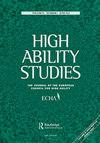低动机和没有高动机是一样的吗?CSAS-R与SAAS-R的比较
IF 1.8
4区 教育学
Q2 EDUCATION, SPECIAL
引用次数: 3
摘要
本研究旨在探讨学业成就挑战量表修订版(CSAS-R)与学校态度评估调查修订版(SAAS-R)项目与因素之间的关系,以确定CSAS-R上的负向量表是否与SAAS-R上的负向量表测量的构念相同。所有的SAAS-R项目都是积极的措辞,所有的分量表都是用来衡量构念的积极表现的。CSAS-R是SAAS-R的补充工具。所有项目都代表态度、认知或行为的消极表现。在本研究中,我们重点研究了SAAS-R和CSAS中具有直接可比性和互补性的四个构形:积极和消极的学术自我认知、对老师和班级的积极和消极态度、高目标评价和低目标评价、规范和不规范的学习行为。CSAS-R和SAAS-R的比较考察了积极项目(来自SAAS-R)和消极项目(来自CSAS-R)的维度的不同概念,以更好地理解是否同意消极行为或态度的陈述似乎代表了不同意积极行为或态度的陈述的极性。本文章由计算机程序翻译,如有差异,请以英文原文为准。
Is having low motivation the same as not having high motivation? Comparing the CSAS-R and the SAAS-R
The purpose of the current study was to examine the relationships among the Challenges to Scholastic Achievement Scale-Revised (CSAS-R) and The School Attitude Assessment Survey-Revised (SAAS-R) items and factors to determine whether the negative scales on the CSAS-R seemed to be measuring the same constructs as those that are measured on the SAAS-R. All SAAS-R items are positively worded, and all subscales are designed to measure positive manifestations of the constructs. The CSAS-R is a complementary instrument to the SAAS-R. All items represent negative manifestations of attitudes, cognitions, or behaviors. For this study, we focused on the four constructs from the SAAS-R and the CSAS that are directly comparable and complementary: positive and negative academic self-perceptions, positive and negative attitudes toward teachers and classes, high and low goal valuation, and regulated and unregulated study behavior. This comparison of CSAS-R and SAAS-R examined alternative conceptions of the dimensionality of the positive items (from the SAAS-R) and the negative items (from the CSAS-R) in an effort to better understand whether agreeing to statements about negative behaviors or attitudes seemed to represent the polar opposite of disagreeing to statements about positive behaviors or attitudes.
求助全文
通过发布文献求助,成功后即可免费获取论文全文。
去求助
来源期刊

High Ability Studies
Multiple-
CiteScore
4.80
自引率
11.10%
发文量
7
期刊介绍:
High Ability Studies provides a forum for scholars in a variety of disciplines associated with the development of human abilities to their highest level. It is a medium for the promotion of high ability, whether through the communication of scientific research, theory, or the exchange of practical experience and ideas. The contents of this journal are unique in reflecting concerns and recent developments in this area from childhood and across the whole life span in a variety of contexts. Far from being restricted to the traditional focus on high-level cognitive development, it also presents investigations into all other areas of human endeavour, including sport, technology, the arts, business, management and social relations.
 求助内容:
求助内容: 应助结果提醒方式:
应助结果提醒方式:


